Step into the Grandeur of Piazza Navona, Rome: What to See and Do
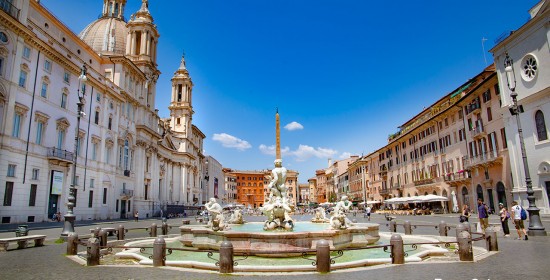
Buongiorno and welcome to Stefano’s RomeCabs, Rome’s top-rated tour company for Rome limousine tours, private tours in Italy, and Italy Transfer Services since 2004. The Eternal City of Rome is a treasure trove of history, culture, and architectural wonders. Among its many iconic landmarks, Piazza Navona stands as one of the must-see squares in Rome with so many things to see and do beckoning travelers to immerse themselves in its rich heritage and vibrant charm.
Piazza Navona's enchanting allure has earned it a prominent place on our most popular Rome tours and Rome Shore Excursions from Civitavecchia. Some of our most popular Rome Tours that include Piazza Navona are:
- Panoramic Rome Tour
- Tour Rome as Romans Do
- Rome Town and Country Tour
- Rome Pre-Cruise Tour
- Panoramic Rome For Cruisers Tour from Civitavecchia
As you stroll through the cobblestone streets of Rome, make sure to carve out time for a visit to Piazza Navona, a place where the past and present converge in a harmonious dance.
Piazza Navona, Rome: What to See and Do
History of Piazza Navona
Piazza Navona traces its origins to the 1st century AD when it bore witness to the grandeur of the "Stadium of Domitian". Commissioned by Emperor Titus Flavius Domitianus in 80 AD, the stadium, also known as the Circus Agonalis, was a testament to Rome's prowess in engineering and entertainment.
The Stadium of Domitian, a colossal amphitheater with a distinctive elliptical shape, was dedicated in AD 86 as part of an Imperial building program at the Field of Mars. Constructed primarily for athletic contests, it marked Rome's first permanent venue for competitive athletics, accommodating approximately 30,000 spectators. The architectural marvel mirrored Greek stadia and featured robust brick and concrete substructures clad in marble, with a layout reminiscent of the Circus Maximus.
A Roman Stadium for Triumphs and Tragedies
The stadium became the epicenter of Roman athleticism, hosting a myriad of contests and celebrations, including the Capitoline Games initiated by Domitian. Over the years, it witnessed the triumphs of gladiators and charioteers, as well as the tragic martyrdom of St. Agnes during the reign of Emperor Diocletian.
Subsequent to a brief stint as a venue for gladiator shows following the fire damage to the Colosseum in AD 217, the arcades of the stadium were repurposed for unconventional uses, including, according to the Historia Augusta, as makeshift brothels during the reign of Emperor Elagabalus.
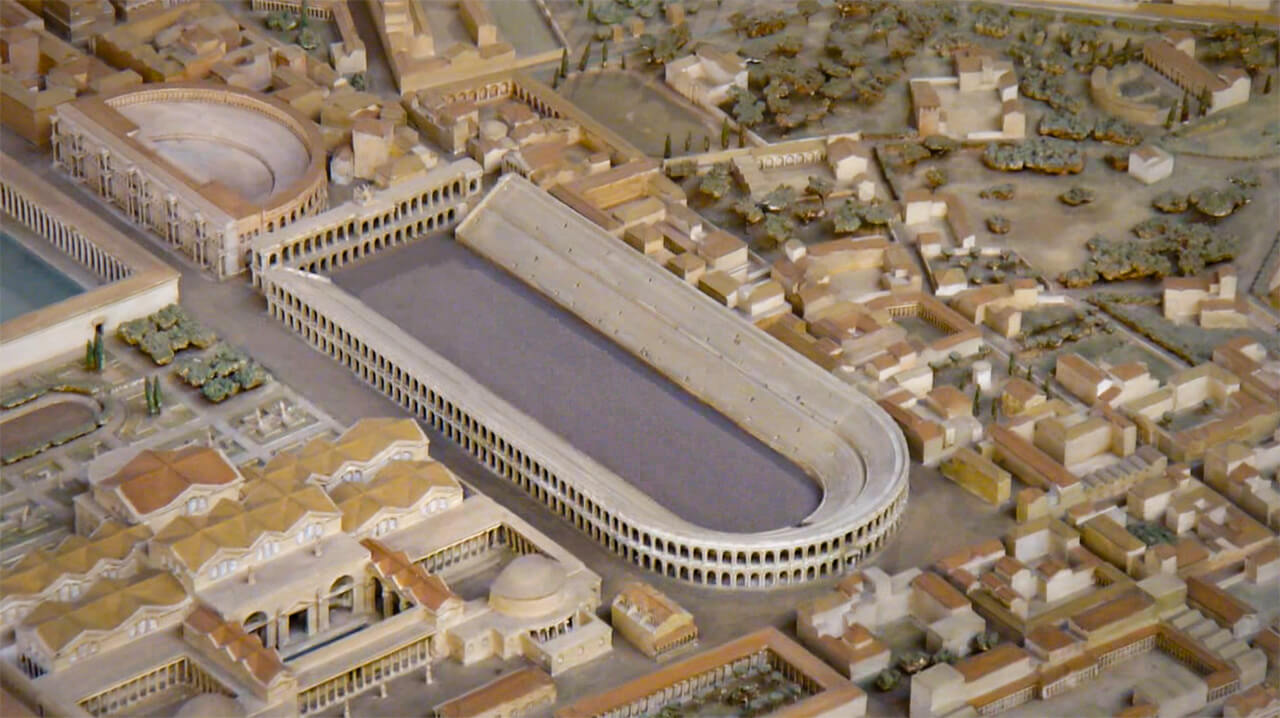
The Decline and Transformation of the Stadium of Domitian
As Rome faced economic and political upheavals in the later Imperial and post-imperial eras, the stadium underwent a gradual decline in its original purpose. With the fall of the Roman Empire, the arcades, once bustling with the fervor of athletic competitions, now provided living quarters for the poor, and the arena became a communal gathering space. With the city's population concentrated in Campus Martius, the Stadium of Domitian, though dense with history, gradually faded into obscurity.
Fast forward to the late 15th century, and Piazza Navona began its transformation into the vibrant square we know today. Defined as a public space during this period, it became the focal point of Baroque Roman architecture and art during the pontificate of Innocent X in the mid-17th century.
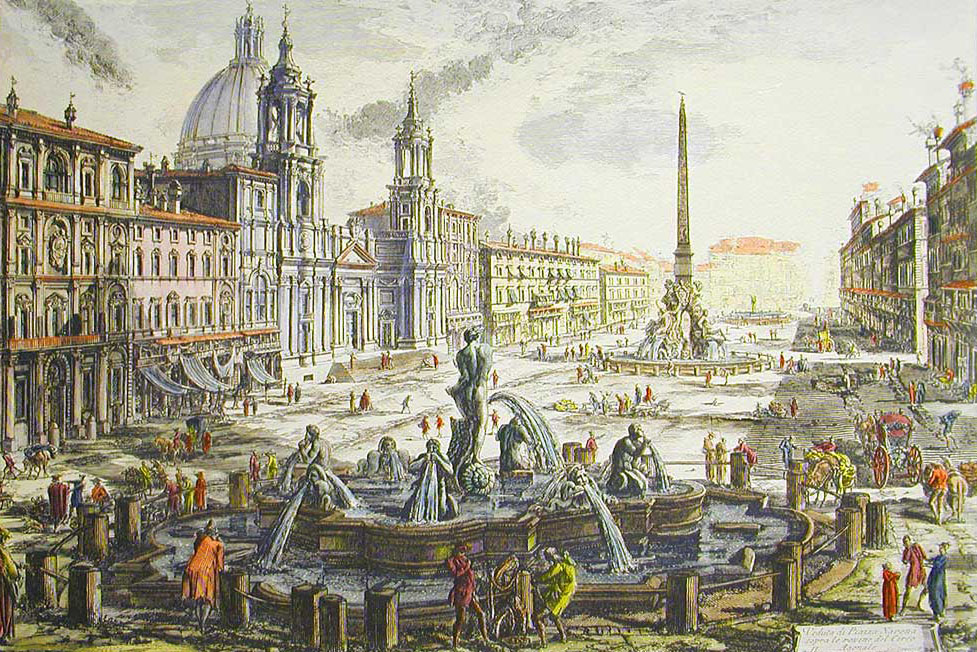
How did Piazza Navona get its name?
Piazza Navona acquired its name through a linguistic evolution that can be traced back to its original Latin designation. In ancient Rome, the area where Piazza Navona is situated was known as the "Circus Agonalis" or the "Stadium of Domitian". The term "Agonalis" has its roots in the Greek word "agon", meaning a contest or competition, emphasizing the original use of the space for athletic competitions and contests.
Over time, as Rome underwent various transformations, the name evolved. In the Middle Ages, the area began to be referred to as the "in agone" or "agnone", which, in medieval Italian, meant a large open space or a competition area. This terminology reflected the historical use of the space as a venue for public events and contests.
As the square continued to evolve and take on a more permanent character, especially during the Renaissance and Baroque periods, the name further transformed into "Navona." The origin of "Navona" is debated, but some theories suggest that it could be a corruption or contraction of the term "in agone."
In any case, by the late 15th century, the square had become commonly known as Piazza Navona, solidifying its identity as a central public space in Rome.
Piazza Navona’s Architectural Marvels
Piazza Navona stands as a masterpiece of Roman architecture and urban design, featuring a stunning collection of architectural marvels. From the exquisite fountains to the grand church that adorn the square, each is a symbol of Rome's rich artistic heritage and the enduring legacy of its brilliant architects. Discover why Piazza Navona is a celebration of beauty and history at every turn.

Fountain of Four Rivers (Fontana dei Quattro Fiumi)
In the very heart of Piazza Navona stands the magnificent Fountain of the Four Rivers (Fontana dei Quattro Fiumi), a sculptural masterpiece conceived and executed by the genius of Baroque art, Gian Lorenzo Bernini. Commissioned by Pope Innocent X and unveiled in 1651, this fountain is more than a mere structure; it's a poetic expression in stone, capturing the essence of the known world during that era.
Bernini's design was chosen through a somewhat secretive and competitive process. Though Bernini had fallen out of favor with Innocent X due to his close association with the previous pope, Urban VIII, he managed to secure the commission by presenting a model of the fountain that captivated the pope's imagination. The story goes that Bernini’s model was displayed where the pope would see it by chance, and its grandeur immediately won over Innocent X.
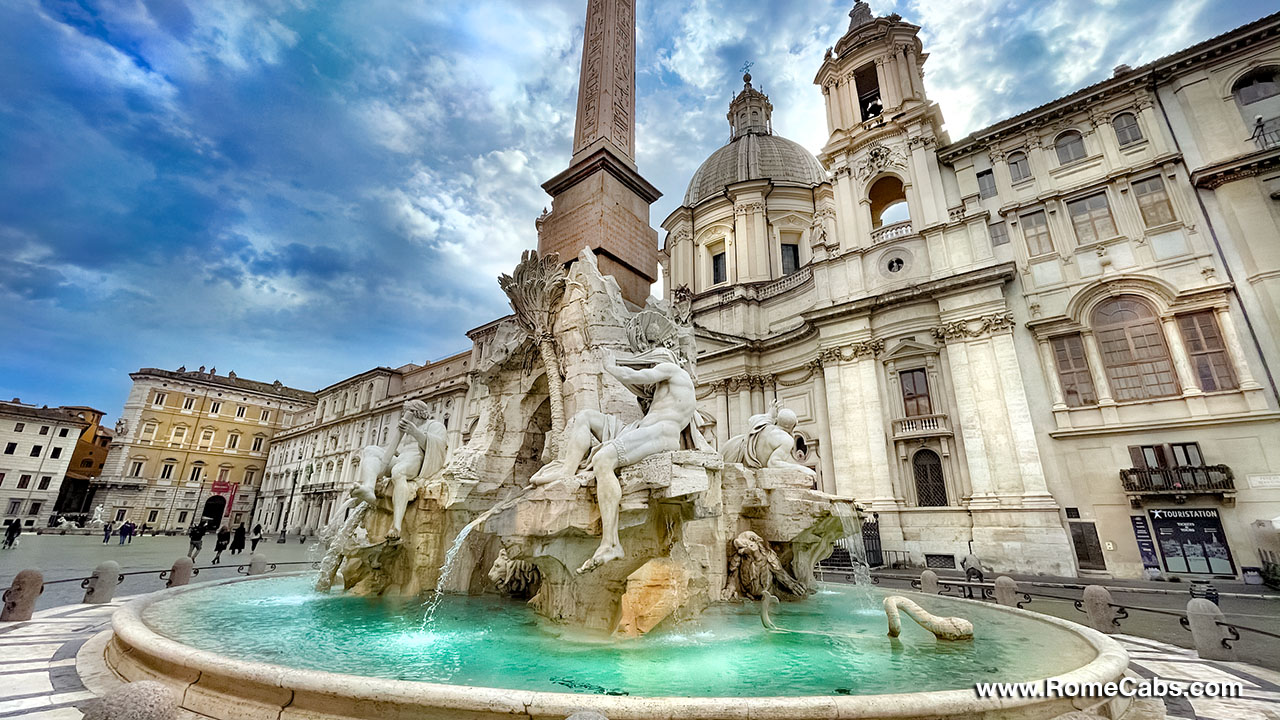
Artistic and Symbolic Elements of the Fountain of the Four Rivers
The Fountain of the Four Rivers is a monumental structure that features an ancient Egyptian obelisk at its center, symbolizing the Church's triumph over paganism and its authority over the known world. The obelisk itself, originally from the Circus of Maxentius on the Appian Way, was relocated to Piazza Navona to become the crowning feature of Bernini’s fountain.
The four colossal figures that surround the base of the obelisk represent the major rivers of the four continents as they were known in the 17th century:
- The Nile (Africa): This figure is depicted with a cloth covering its head, symbolizing the mystery and unknown origins of the Nile River at the time. The face of the Nile is serene, reflecting the life-giving qualities of the river, which was considered the source of fertility in Egypt.
- The Danube (Europe): The figure representing the Danube, Europe’s second-longest river, is shown touching the papal coat of arms, symbolizing the Church's influence in Europe. The Danube was significant as the closest major river to Rome, representing the heart of Christendom.
- The Ganges (Asia): The Ganges is portrayed as a muscular figure holding an oar, indicative of the river’s navigability. The Ganges was revered as a sacred river in Hindu culture, and its representation in the fountain acknowledges the spiritual significance of Asia.
- The Rio de la Plata (Americas): The figure symbolizing the Rio de la Plata is seen recoiling from a snake, a reference to the dangers of the New World. The Rio de la Plata, in present-day Argentina and Uruguay, was a symbol of the untapped wealth and the potential for the spread of Christianity in the Americas.
Each of these figures is accompanied by flora, fauna, and other symbolic elements that reflect the unique characteristics of their respective rivers and continents. For example, the Rio de la Plata is depicted with coins scattered around it, symbolizing the wealth of the Americas.
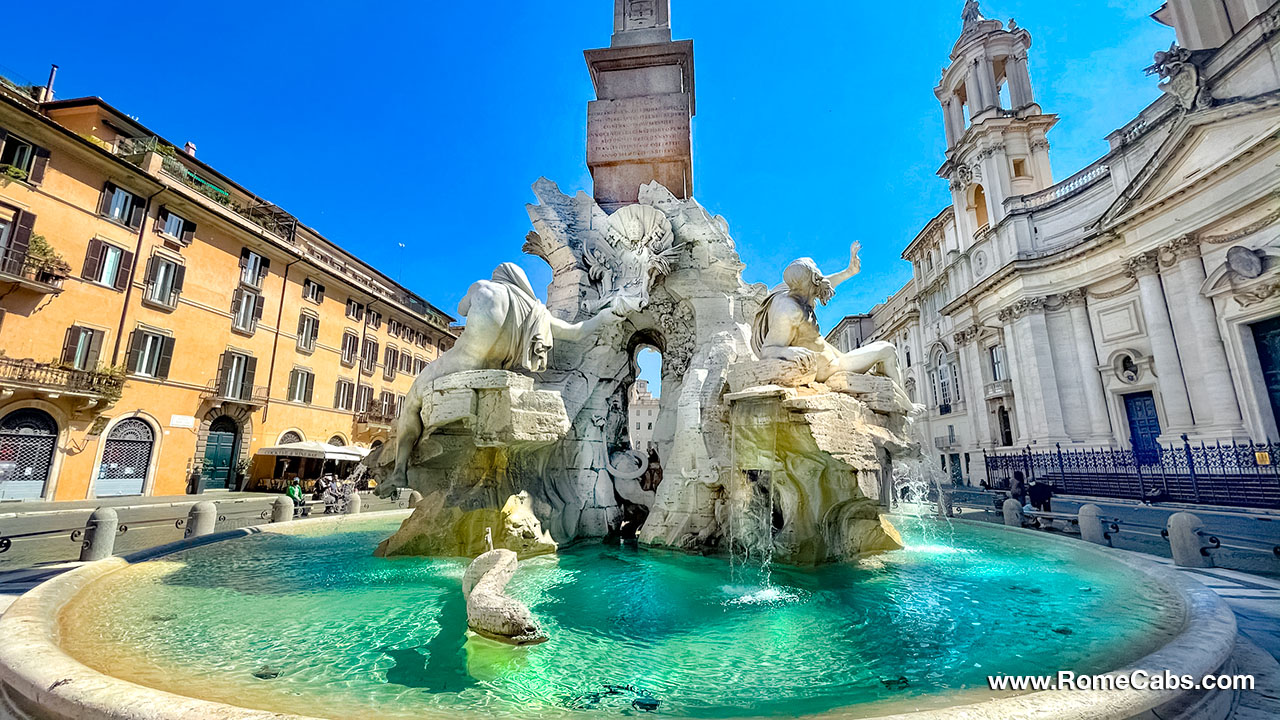
The Egyptian Obelisk of the Fountain of Four Rivers
Rising majestically from the center of the fountain is an ancient Egyptian obelisk, adding a touch of classical grandeur to the Baroque ensemble. Topped with the Pamphili family emblem, the dove, the obelisk serves as a unifying element, connecting the heavens with the flowing waters below. The pope clearly aimed to leave a lasting legacy that would reinforce the prominence of the Pamphili family, to which he belonged.
Fountain of the Moors (Fontana del Moro) - Piazza Navona
The Fountain of the Moors (Fontana del Moro) is one of the three stunning fountains that adorn Piazza Navona, a square known for its vibrant history and baroque artistry. Located at the southern end of the piazza, this fountain offers a fascinating glimpse into the artistic collaboration between two of the most influential sculptors of the 16th and 17th centuries, Giacomo della Porta and Gian Lorenzo Bernini.
The original design of the Fountain of the Moors was crafted by Giacomo della Porta in 1575, as part of a broader project to embellish Rome's public spaces with grand fountains. Della Porta's work on the fountain featured a large central basin, from which four Tritons—mythical sea gods often depicted as half-human, half-fish—emerge. These Tritons are depicted in dynamic poses, their muscular forms and expressive faces conveying the power and mystique of the sea.
The Fountain of the Moors is rich in symbolism, with its Tritons and central figure representing the forces of nature and the mythological connection between humans and the sea. The Moor, as portrayed by Bernini, is a powerful figure, grappling with the dolphins as water cascades around them, symbolizing the eternal struggle and harmony between man and nature.
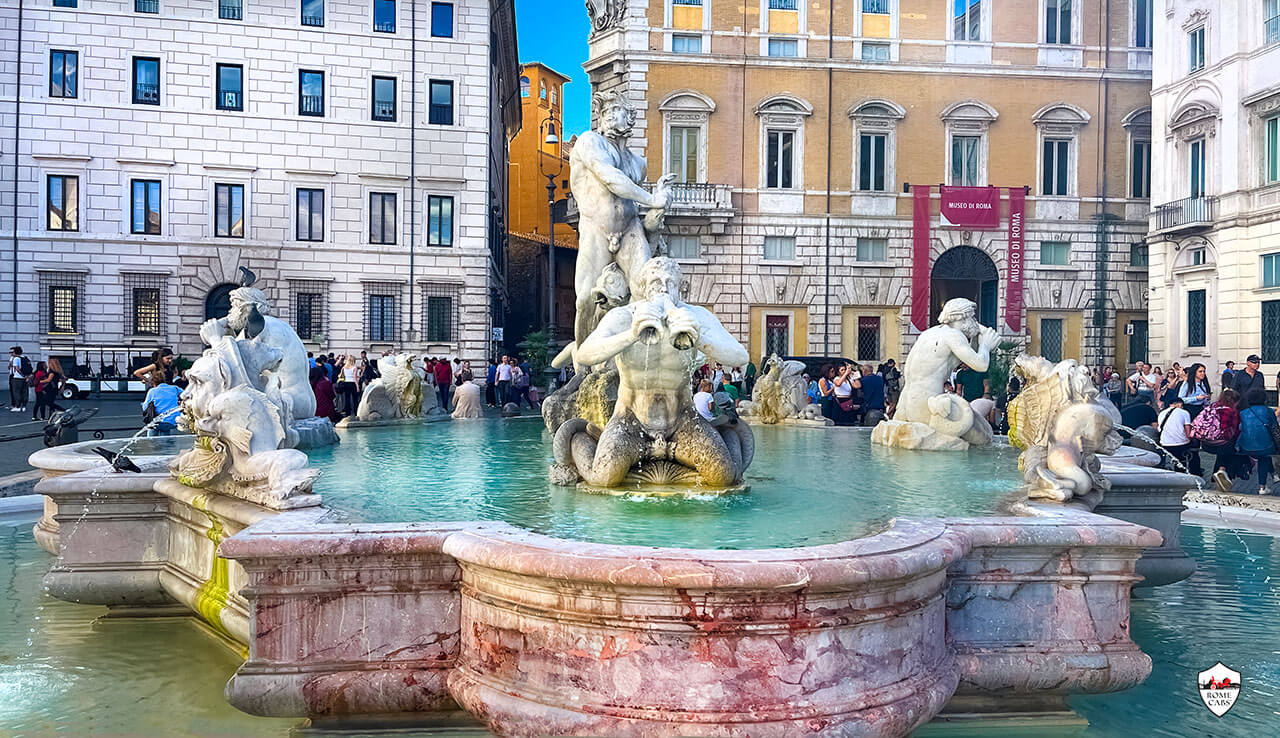
Fountain of Neptune (Fontana del Nettuno), Piazza Navona
The Fountain of Neptune (Fontana del Nettuno) at the northern end of Piazza Navona is a striking example of Renaissance and later additions blending seamlessly to create a harmonious work of art. This fountain, along with the Fountain of the Moors and the Fountain of the Four Rivers, forms the trio of iconic fountains that make Piazza Navona one of Rome's most celebrated public squares.
The Fountain of Neptune was originally designed by Giacomo della Porta in 1574 as part of Pope Gregory XIII's initiative to enhance the beauty of Rome's public spaces. Della Porta, a prominent architect and sculptor of the late Renaissance, was tasked with creating a functional yet aesthetically pleasing fountain that would provide water to the northern end of the piazza.
The fountain remained in this relatively unadorned state for over 300 years until the late 19th century. During this time, there was a renewed interest in embellishing the urban landscape of Rome, and the Fountain of Neptune was finally completed. In 1878, the sculptor Antonio Della Bitta was commissioned to create the central figure of Neptune, the Roman god of the sea, which was added to the existing basin.
The central figure of Neptune symbolizes the power of the sea and the human desire to control nature. His commanding presence in the fountain serves as a reminder of Rome's historical relationship with water, from the construction of aqueducts to the grandeur of its public fountains. The surrounding figures add to the narrative, depicting a vibrant underwater scene that captures the imagination and invites viewers to appreciate the mythological and artistic elements at play.
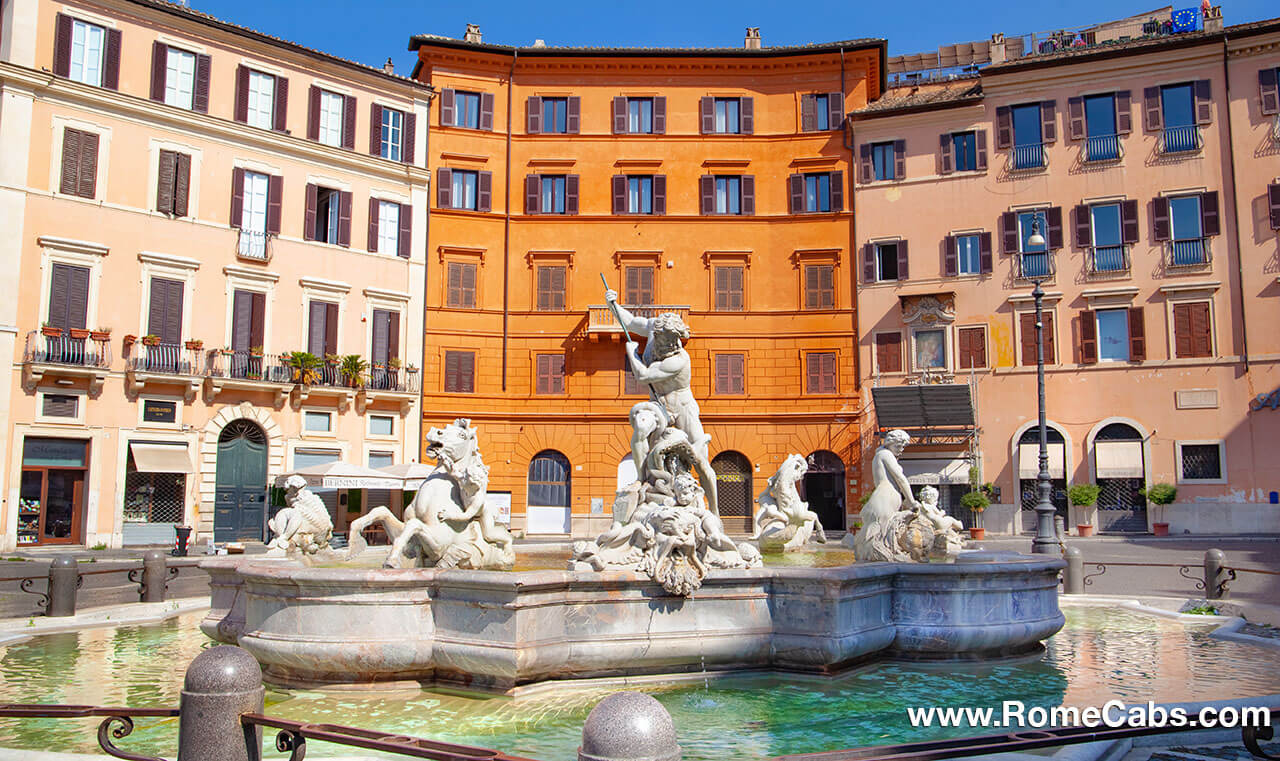
Sant'Agnese in Agone: Baroque Splendor
Amidst the grandeur of fountains and palaces, the church of Sant'Agnese in Agone stands as a spiritual gem. Designed by the eminent Baroque architect Francesco Borromini, in collaboration with Girolamo Rainaldi and Carlo Rainaldi, this church is dedicated to St. Agnes, the patron saint of virgins. Sant'Agnese in Agone stands as a striking example of Baroque architecture, a style that emerged in the 17th century and sought to evoke intense emotion and awe.
Who is Saint Agnes?
Sant'Agnese in Agone pays homage to Saint Agnes, a revered figure in Christian history known for her unwavering faith and martyrdom. Born in the early 3rd century in Rome, Agnes was a young Christian girl from a noble family. Agnes's life took a tragic turn during the Roman persecution of Christians under Emperor Diocletian. Refusing to renounce her Christian beliefs and marry a pagan suitor, she faced persecution and was ultimately martyred. Legend has it that various attempts to harm her, including fire and decapitation, were miraculously thwarted, solidifying her status as a symbol of purity and martyrdom.
Why is the church named "Sant'Agnese in Agone"?
The name "Sant'Agnese in Agone" has an intriguing history. The term "Agone" does not refer to agony, as one might assume, but instead is derived from the Latin word "agones", meaning games or competitions. This name reflects the church's location in proximity to the Stadium of Domitian, which as we know was also known as the "Circus Agonalis" or "in agone." The term alludes to the historical use of the square for various competitions and athletic events during ancient times.
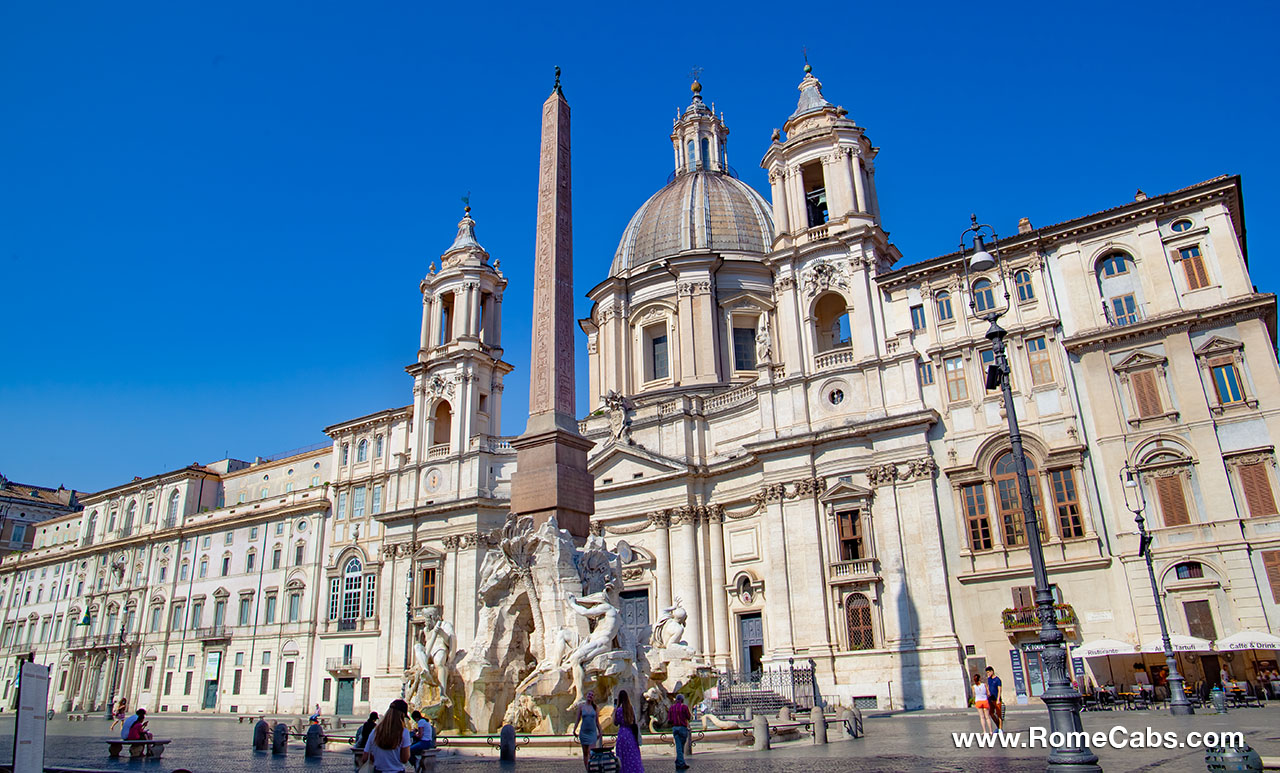
Enjoy the Vibrant Atmosphere of Piazza Navona
Piazza Navona is not just a feast for the eyes; it's a sensory delight. Street musicians who frequently perform in Piazza Navona, with an eclectic mix of instruments, create a harmonious backdrop to your exploration.
As you stroll through Piazza Navona, portrait artists capture the expressions of their subjects with remarkable skill, while painters proudly display their works, transforming the square into an open-air gallery.
The vibrant atmosphere is further enriched by charming outdoor cafés and restaurants, tempting you to indulge in a delightful meal amidst the lively ambiance. Yes, these establishments may lean towards the "touristy" side, and the cost may extend beyond the culinary experience to include the prime "real estate" location and the captivating "view." Nevertheless, treating yourself to a moment of relaxation at an outdoor café overlooking this bustling square could be a worthwhile indulgence.
Wandering along the perimeter of Piazza Navona reveals an array of shops offering local treasures and souvenirs. Explore these establishments to discover unique mementos that capture the essence of this iconic Roman square, making your visit a truly memorable and sensorially rich experience.
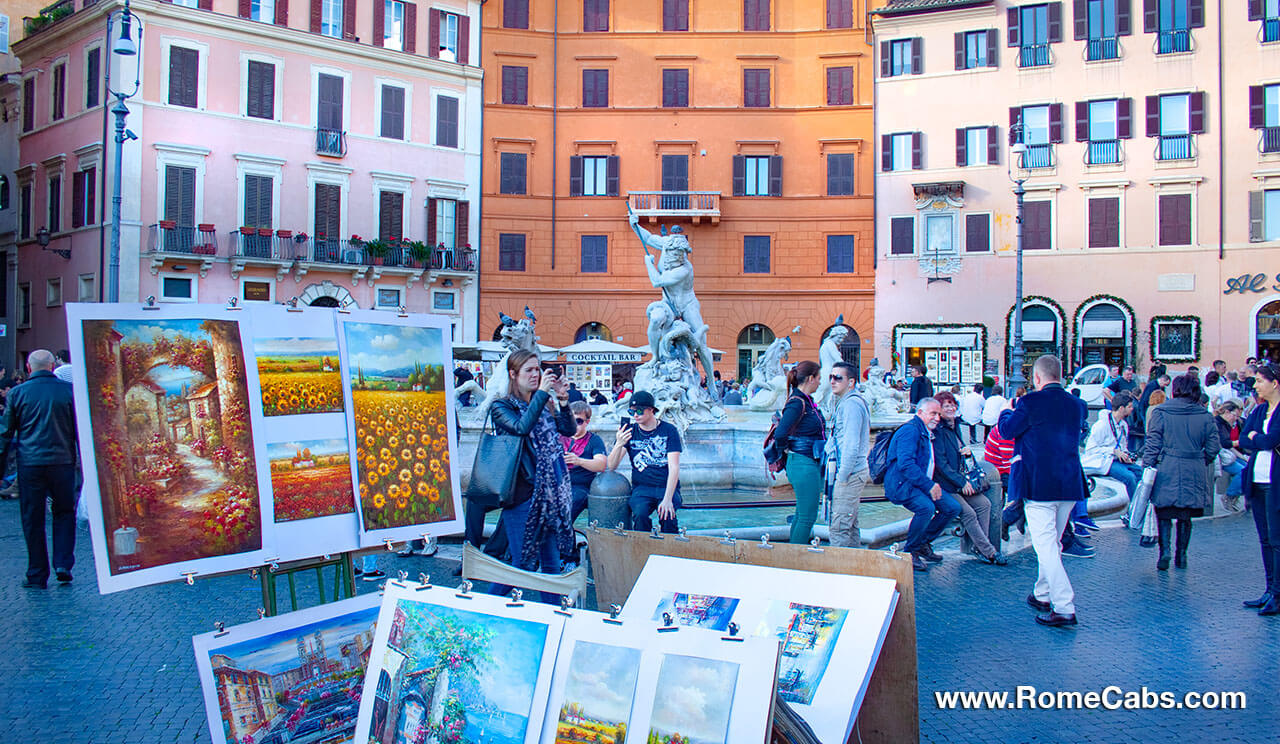
What to see near Piazza Navona - Explore Nearby Places
Conveniently situated near other iconic landmarks like the Pantheon and Campo de' Fiori, Piazza Navona is easily accessible on foot. Take a leisurely stroll through the narrow streets of Rome, and you'll find yourself in the midst of this historic square.
Pasquino: A Symbol of Free Speech
Venture just beyond the square Piazza di Pasquino, named after the renowned "talking" statue Pasquino, positioned against Palazzo Braschi's corner, was once known as "Piazza di Parione" and was a gathering place for booksellers, writers, and artists, earning the additional title of "Piazza dei Librai".
Pasquino, a fragment of an ancient Hellenistic statuary group, was discovered during Cardinal Oliviero Carafa's renovations in 1501 and placed on a pedestal in the corner of Palazzo Braschi.
The origin of the name Pasquino remains uncertain, with various interpretations linking it to an innkeeper, barber, school teacher, or cobbler, all named Pasquin. Initially, the statue became a platform for anonymous satires, evolving into a hub for fierce political critiques, particularly targeting the pope and other prominent figures, leading to the term "pasquinata". Despite the risk of destruction, Pasquino endured, forming part of the "congrega degli witti" alongside other "talking statues" like Marforio, Madama Lucrezia, Abbot Luigi, the Porter, and the Babuino.
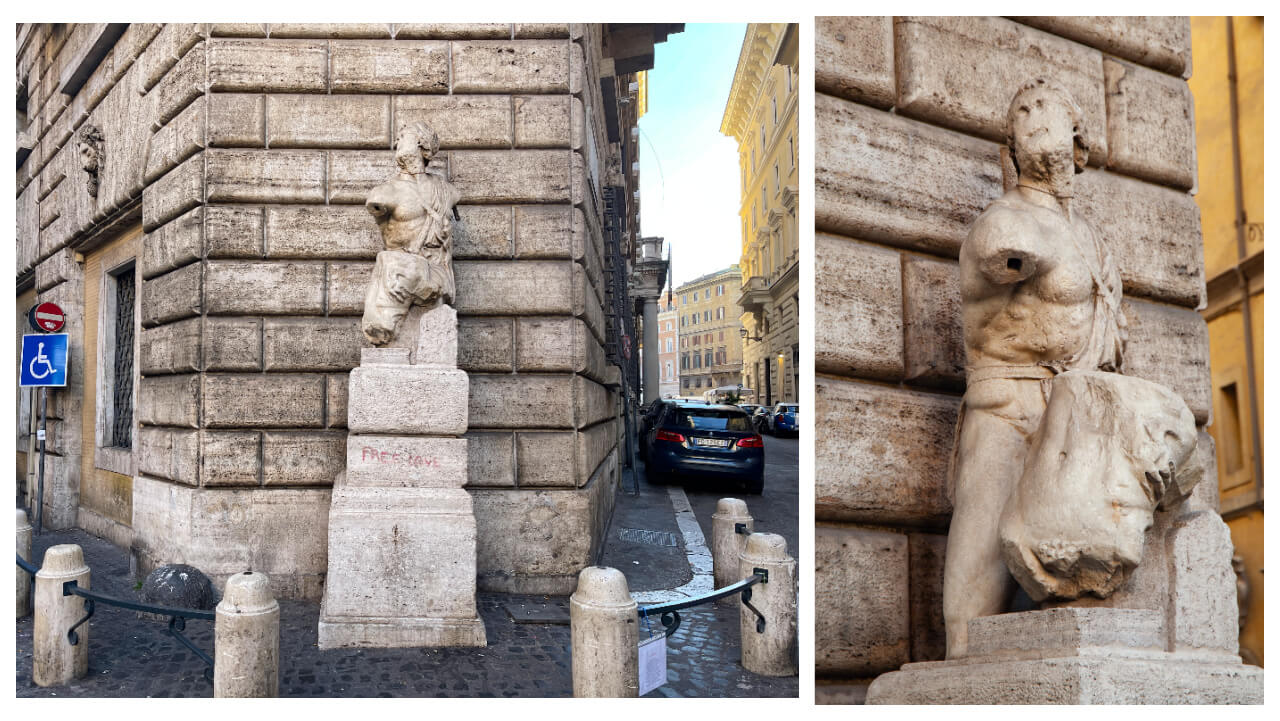
The Pantheon: A Divine Marvel
Just a short, delightful walk from the vibrant Piazza Navona brings you to the equally historic Piazza della Rotonda, home to one of Rome's most iconic and well-preserved ancient structures—the Pantheon. This architectural masterpiece, initially constructed around 27-25 BC by Marcus Agrippa and later rebuilt by Emperor Hadrian around 118-125 AD, was originally dedicated to all the gods of ancient Rome. Its transformation into a Christian church in the 7th century ensured its preservation through the ages, and today, it remains a place of worship as the Basilica of St. Mary and the Martyrs.
The Piazza della Rotonda, the square in front of the Pantheon, is a lively and bustling area that perfectly encapsulates the charm of Rome's historic center. The piazza is named after the Pantheon’s round shape, or "rotonda", and has been a gathering place for Romans and visitors for centuries. In the center of the square stands a beautiful fountain topped with an Egyptian obelisk, known as the Fontana del Pantheon. The fountain was designed by Giacomo Della Porta in 1575 and later adorned with the obelisk in 1711 during the papacy of Clement XI.
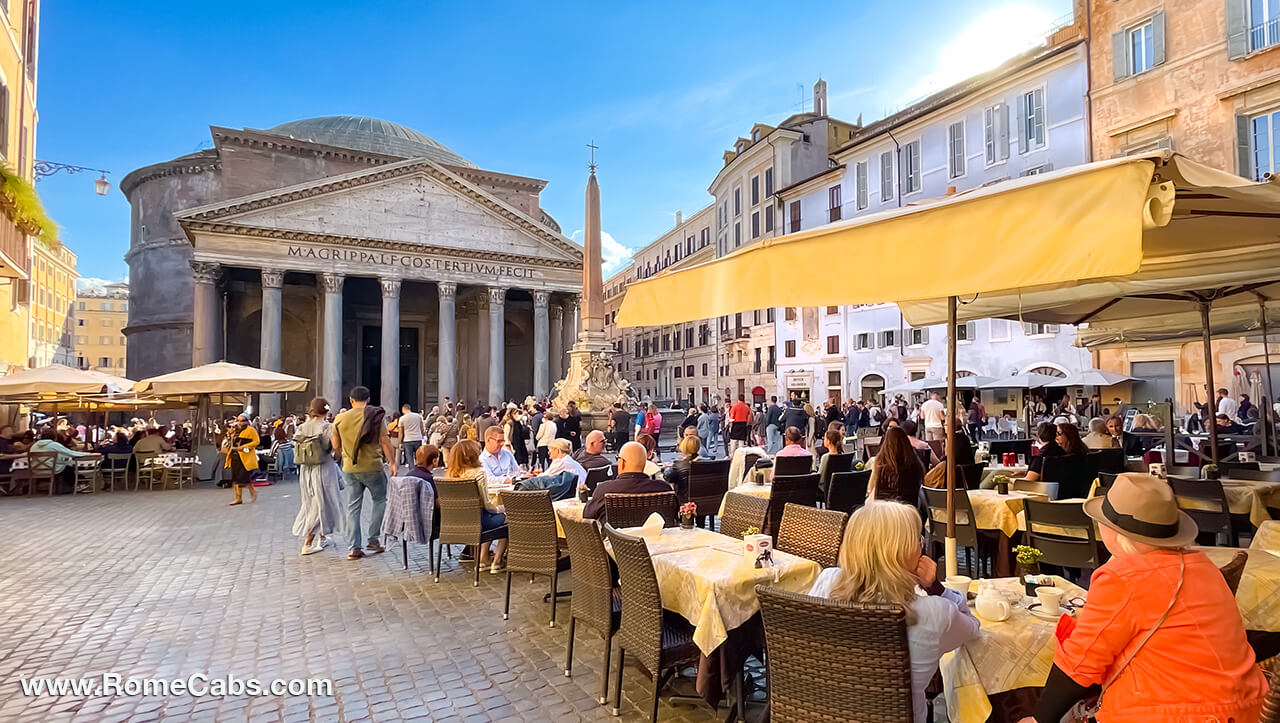
Campo de' Fiori: A Lively Market Square
Venture through the charming streets surrounding Piazza Navona, and you'll soon find yourself at Campo de' Fiori, a lively market square that buzzes with activity during the day and transforms into a vibrant nightlife hub in the evening. Explore the bustling market stalls offering fresh produce, flowers, and local delights.
As the sun sets, the square comes alive with a diverse array of restaurants, bars, and street performers, making it a perfect complement to the timeless elegance of Piazza Navona.
Church of San Luigi dei Francesi: Caravaggio's Artistry
A short walk from Piazza Navona brings you to the Church of San Luigi dei Francesi, a true haven for art enthusiasts. This church, dedicated to Saint Louis, the King of France, is renowned for its collection of works by Michelangelo Merisi da Caravaggio, one of the most influential painters of the Baroque era. Inside, you will find the Contarelli Chapel, which houses Caravaggio's famous trilogy of paintings depicting the life of Saint Matthew: "The Calling of Saint Matthew", "The Inspiration of Saint Matthew", and "The Martyrdom of Saint Matthew".
These masterpieces are celebrated for Caravaggio's revolutionary use of chiaroscuro, a technique that contrasts light and shadow to create dramatic intensity and depth. The emotional realism and vivid details in these paintings draw viewers into the narratives, making the experience of visiting San Luigi dei Francesi not just a cultural highlight, but a deeply spiritual one as well. The church itself, completed in 1589, is also an architectural gem, with its elegant façade and richly decorated interior reflecting the artistic tastes of the late Renaissance period.
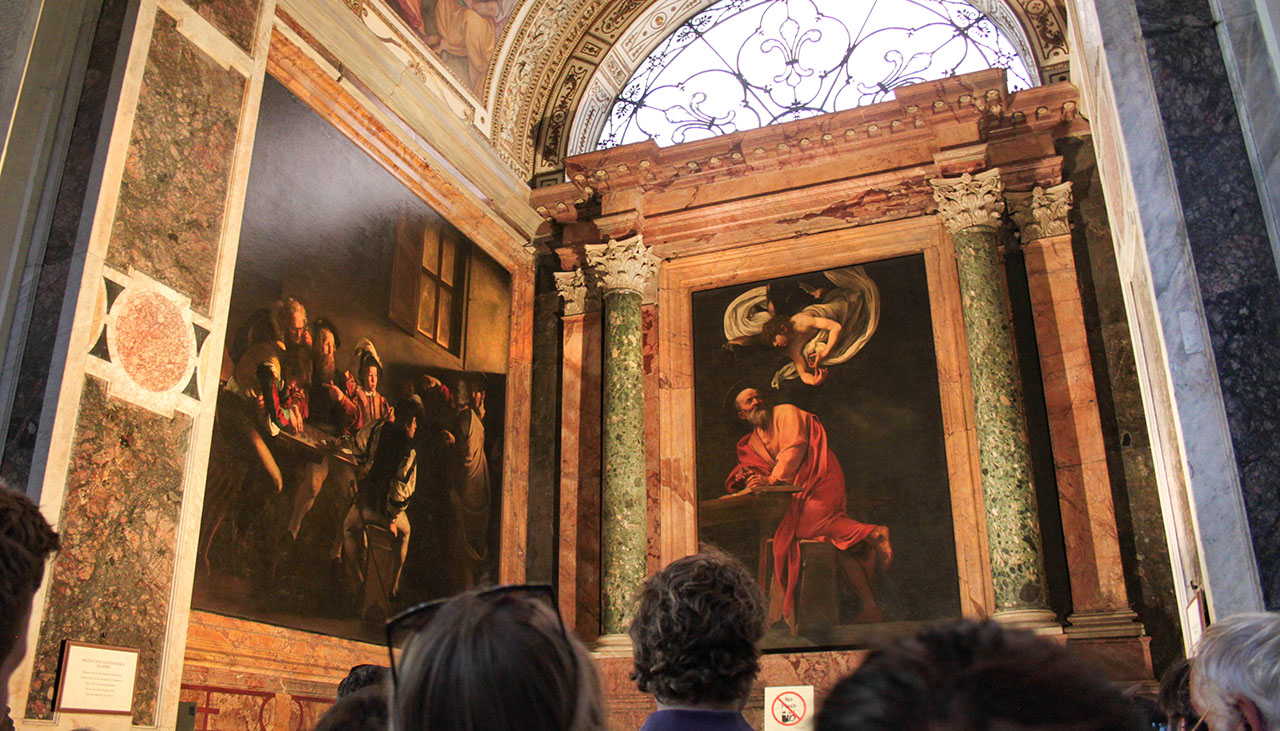
Church of Sant'Ignazio: A Baroque Marvel
As you continue your exploration of Rome’s historic center, the Church of Sant'Ignazio di Loyola presents itself as a stunning example of Baroque artistry and architectural ingenuity. Built between 1626 and 1650, this church was designed by Jesuit architect Orazio Grassi and is dedicated to Saint Ignatius of Loyola, the founder of the Society of Jesus (Jesuits). The most striking feature of Sant'Ignazio is its trompe-l'oeil ceiling fresco, painted by Andrea Pozzo, a Jesuit brother and master of perspective.
The fresco, titled "The Apotheosis of Saint Ignatius", creates the illusion of a grand dome where there is actually a flat ceiling, showcasing Pozzo's extraordinary skill in manipulating perspective. As you stand in the center of the nave and gaze upwards, the ceiling seems to open up to the heavens, with figures of angels, saints, and allegorical representations soaring into the sky. The church's richly decorated interior, with its gilded altars and sumptuous chapels, further adds to its grandeur, making Sant'Ignazio a must-see for anyone interested in Baroque art and architecture.
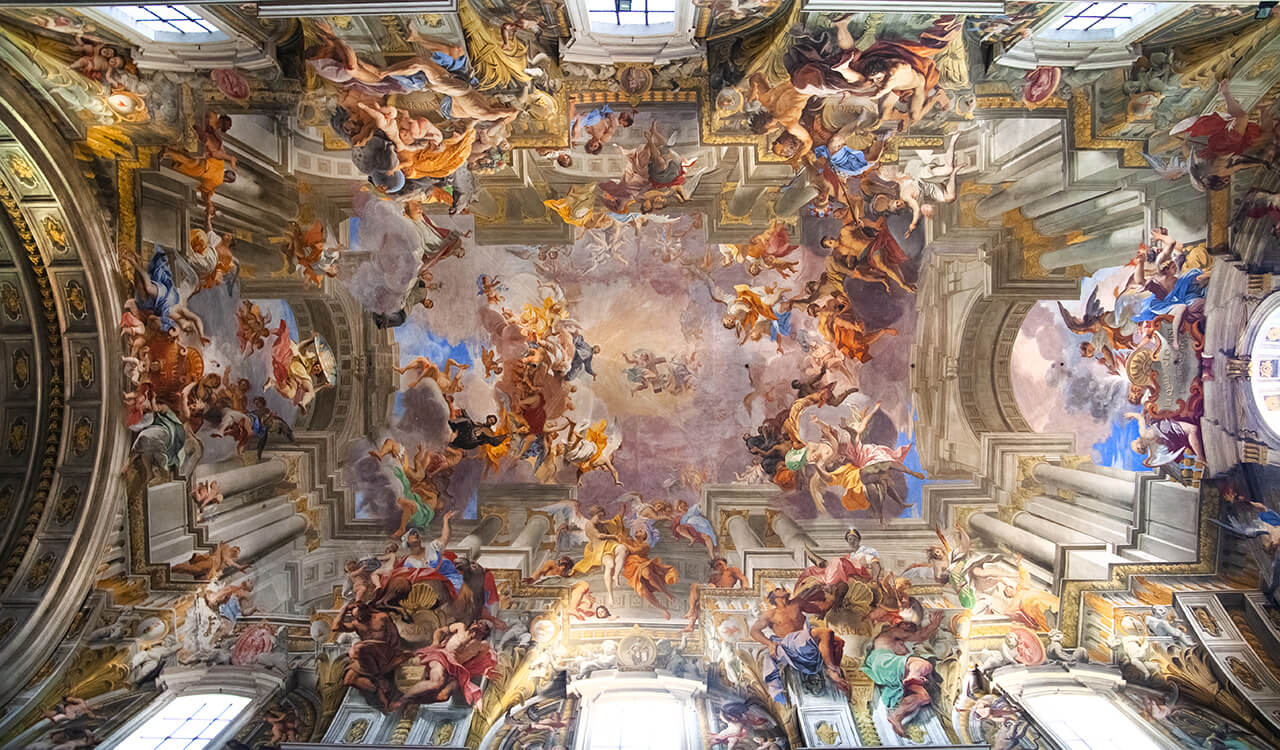
Church of Saint Agostino: Artistic Riches
The Church of Saint Agostino, located near Piazza Navona, is a treasure trove of Renaissance and Baroque art, offering visitors a chance to admire works by some of the most celebrated artists of the time. Built in 1483 using materials repurposed from the Colosseum, the church is one of the first Roman churches to be constructed in the Renaissance style. Its relatively plain façade belies the artistic riches found within.
Among its most famous artworks is Caravaggio's "Madonna di Loreto", also known as "Madonna of the Pilgrims", a powerful and realistic depiction of the Virgin Mary holding the Christ Child while two humble pilgrims kneel before her. The painting is notable for its earthy realism and the way Caravaggio used ordinary people as models, bringing a sense of immediacy and humanity to the religious scene.
The church also houses Guercino's "Saints Augustine, John the Evangelist, and Jerome," a dynamic and expressive altarpiece, as well as Raphael's "Prophet Isaiah," a fresco that showcases the artist's skill in portraying majestic figures with a sense of gravitas.
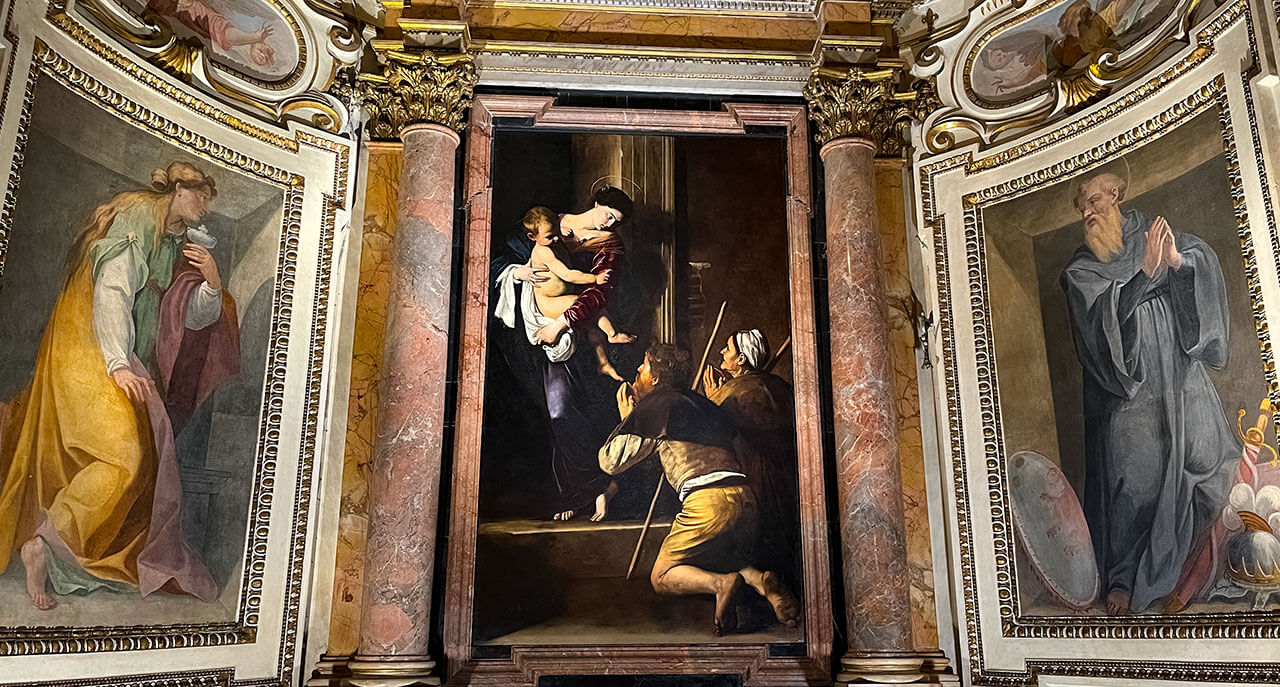
Bramante Cloister (Chiostro Del Bramante): A Tranquil Retreat
Experience the serene beauty of the Bramante Cloister, a 16th-century structure commissioned by Cardinal Oliviero Carafa and designed by Donato Bramante. Attached to the Church of S. M. della Pace, the cloister features a two-story courtyard with beautiful colonnades, a music hall, and a theater. It offers a peaceful escape from the crowds, making it a local favorite for coffee or a quiet moment of reflection.
Piazza Navona is more than just a square; it's a living testament to Rome's enduring spirit. Its rich history, architectural wonders, vibrant atmosphere, and culinary delights make it a must-visit destination for anyone exploring the Eternal City. So, as you plan your Roman adventure, be sure to include Piazza Navona on your itinerary. Let the magic of this enchanting square transport you to a bygone era while immersing yourself in the vibrant energy of contemporary Rome.
Experience the Wonders of Rome with RomeCabs:
Private Rome Tours and Shore Excursions from Civitavecchia
Immerse yourself in the timeless allure of Rome with RomeCabs, your trusted partner for luxurious and comfortable Rome tours and hassle-free Rome shore excursions from Civitavecchia.
Explore the historic wonders of Rome from the comfort of a private, deluxe vehicle. Visit legendary sites such as Piazza Navona, the Spanish Steps, and the Trevi Fountain, or marvel at the grandeur of the Colosseum as you stroll through Colosseum Square. Our professional English-speaking drivers are experts at navigating the city's vibrant streets and are passionate about sharing intriguing insights into Rome’s rich history and culture.
For travelers arriving via cruise ship, our Rome Shore Excursions from Civitavecchia are thoughtfully designed to fit seamlessly into your limited schedule. Enjoy the convenience of pickup and drop-off right at the pier next to your ship—RomeCabs makes your Roman adventure effortless!
With RomeCabs, you have the freedom to discover Rome at your own pace. Relish the privacy and comfort of your deluxe vehicle, with a personal driver at your service. Your dedicated driver will bring you close to each must-see attraction, minimizing walking distances and giving you more time to soak in the sights. Whether you wish to linger at a particular spot or explore off-the-beaten-path gems, our flexible tours cater to your preferences.
Visit our website to discover more about our Rome Tours and Shore Excursions from Civitavecchia, or reach out to us to craft a customized itinerary that perfectly suits your interests.

Explore More of Italy with private Day Tours from Rome
While in Rome, we wish to remind you that RomeCabs also offers exciting Day Trips from Rome to Tuscany, Rome Countryside Tours, and Day Tours from Rome to Amalfi Coast.
RomeCabs provides quality and reliable airport transfers to Rome, and Civitavecchia cruise port transfers for cruisers sailing from Civitavecchia Cruise Port. For cruisers whose cruise concludes in Civitavecchia, RomeCabs also offers a wide variety of exciting Civitavecchia Post Cruise Tours to Rome, the Countryside, Tuscany, and Umbria to make the most of your disembarkation day!
Experience Rome and Italy like never before with RomeCabs — where your unforgettable memories begin.
We look forward to showing you amazing places in Italy!
* Find RomeCabs online also on:
- RomeCabs FACEBOOK
- RomeCabs PINTEREST
- RomeCabs TWITTER
- RomeCabs INSTAGRAM
- RomeCabs FLICKR Photo Gallery
- Check out more Rome Travel Blogs: https://romecabsdotnet.wordpress.com/
